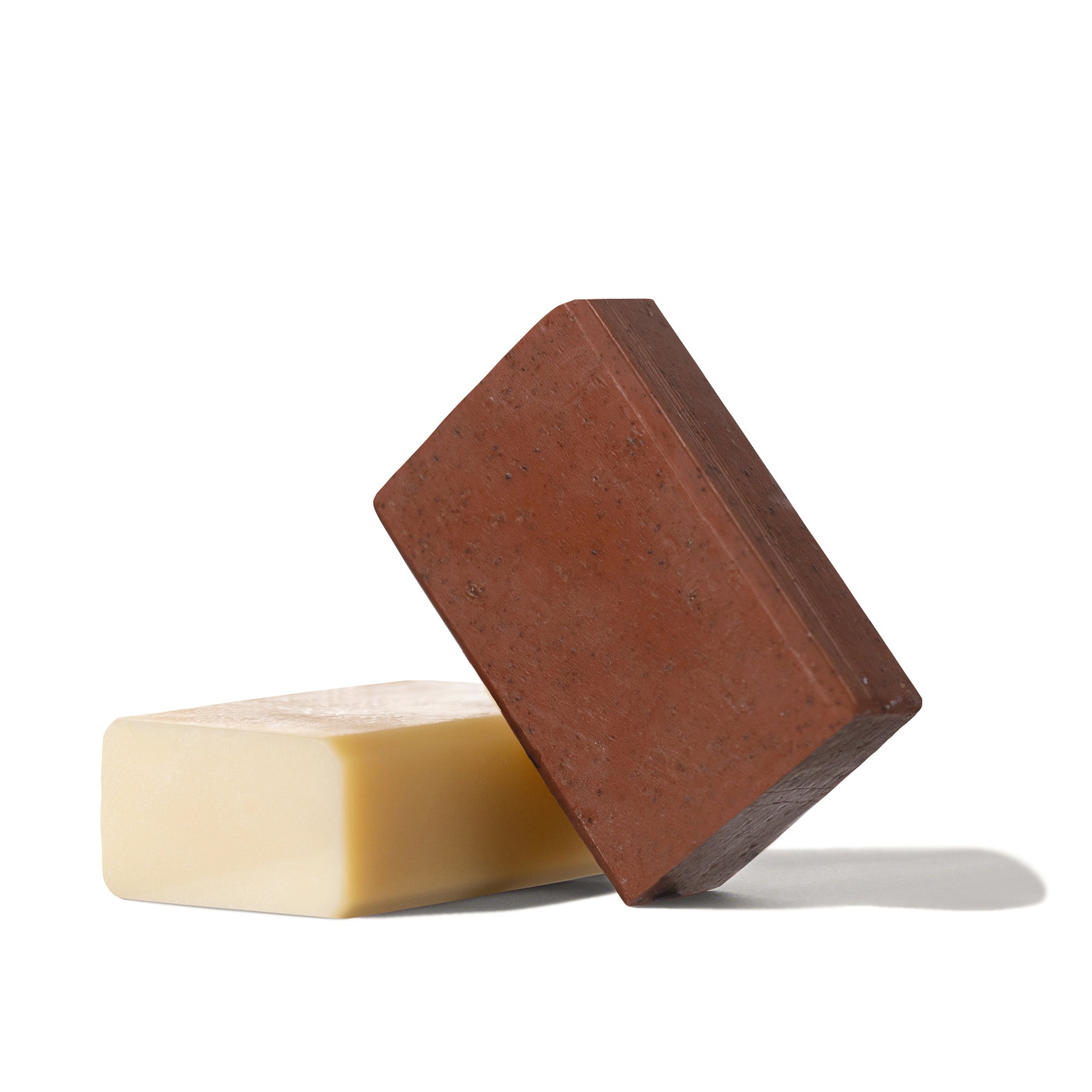What Is Cold-Processed Soap?
Soap is the result of a chemical reaction between fatty acids (oils) and an alkaline solution (lye), which is called saponification.
Cold-processed soap is made by mixing sodium hydroxide (lye) with water, blending it with fatty oils and butters, and adding essential oils and natural colorants like clays, herbs, spices or botanicals. This is done without the use of external heat, hence the name “cold” process. Although it is a much lengthier process than other heated forms of soap-making, it protects the goodness of the ingredients and also allows for a much more gradual saponification.
Once our raw soap mix reaches a custard-like consistency, we pour it into pre-lined wooden slab molds. It takes 24 hours for our liquid soap batter to harden and become soap, or to “saponify”.
How Soap Cleanses Your Skin
When you cold-process soap, the fatty acids of the oils are broken down by the lye. They then form a chain which, on one end loves water, and on another end, loves oil. The oil-loving (lipophilic) end grabs on to the dirt and grime, and the water-loving (hydrophilic) end hangs on to the water that rinses it all away.
Why Are Codex Beauty Soaps Better Than the Rest?
Our soaps are carefully formulated, taking into consideration the properties of the plant oils and butters used. This ensures the soap performs to the highest standard on many different levels: the way it lathers, how it moisturizes and cleanses, its texture and the way it smells.
On top of the oils necessary for soap making, we also plump up our soap with copious amounts of organic shea butter to ensure there is plenty of foat left to go around after saponification! This extra fat, or so called “superfat” remains intact, providing the moisturizing qualities our skin craves.
What’s the Difference Between Cold-Process and Commerical Soap?
To be regulated as “soap” by the FDA, it must be composed mainly of the material you get when you combine fats or oils with an alkali, such as lye. The cleaning action must be done entirely as a result of that material without any additives. This is exactly how we make our Codex Beauty soaps.
Many brands avoid the word “soap” on their labels for this reason. Instead they use terms like “beauty bar” or “moisturizing bar.”
Many conventional products are actually detergents. The cleaning action is done by stripping the body of all oils through synthetic surfactants and various chemical ingredients. The glycerin–which is a natural by-product of cold process soaps–is removed and sold as a sought after ingredient in skincare formulations. Without the natural glycerin content in your commercial bar or shower gel, the soap becomes drying,making your skin “squeaky” clean but itchy and sensitive.
Traditional cold-processed soap differs from industrially made soap in that the glycerin is left in acting as a moisturizing agent.
It also gives the possibility to use an excess of oils and butters— beyond that needed to consume the lye— making them more conditioning andmoisturizing.
It also enables the soap-maker to control the formulation and select the oils—and various other natural additives, such as clays, vegetable or fruit pulps, milks, grains or botanicals —based on the qualities they bring to the soap be it moisture, hardness or lather, for example.
What’s the Difference Between Cold-Processed and Triple Milled Soap?
Milled soap (often referred to as French soap) takes cold-processed soap a step further.
In order to make milled soap, the natural skin-loving glycerin is removed from the original product to avoid clogging up the machinery.
It is then shredded, separated, dried, ground back together, and put through heavy machinery (often with synthetic lubricants) over and over again (up to three times) to form a bar made out of soap flakes.
Synthetic ingredients and fragrances are often added to help the soap survive the machinery, and to make the soap lather, stay hard and have a long shelf life.
What Makes Soap Anti-Bacterial?
Antibacterial soaps (sometimes called antimicrobial or antiseptic soaps) contain certain chemicals not found in plain soaps. Those ingredients are added to many consumer products with the intent of reducing or preventing bacterial infection.
Many liquid soaps labelled antibacterial contain triclosan, an ingredient of concern to many environmental, academic and regulatory groups. Animal studies have shown that triclosan alters the way some hormones work in the body and raises potential concerns for the effects of use in humans. We don’t yet know how triclosan affects humans and more research is needed.
What Else Makes Cold-Pressed Soap Special?
- Glycerin. This humectant attracts the moisture to your skin and keeps it soft. When natural, cold-process soaps are made, glycerin forms as a by-product of the water, butters and oils that are mixed together to make these mild cleansing bars.
- Ethically-sourced, organic oils. We formulated our soap to be free of palm oil. Instead, we use an abundance of other natural and organic fats such as olive oil, coconut oil, shea butter, castor oil, sunflower oil and cocoa butter. These oils and butters not only have a fewer adverse effects on the environment, but are also effective at keeping the skin soft, moisturized and supple.
- Vegan and animal-cruelty-free raw materials (pending certification).
- Rich, creamy lather! We selected nature’s best oils to produce rich, creamy suds.
- Gentle on your nose. Each soap is scented with a unique, carefully calculated blend of four to five essential oils. As much as we love our scents, we keep in mind those with allergies and sensitivities. Your soap will be gentle on your nose but once wet it will fill your bathroom with amazing natural aromas.
- Zero-waste and zero plastic packaging.
- Free of synthetic ingredients: We don’t use these to color, scent, lather, harden or preserve our soap.
- Allergy tested to ensure consumer safety.









